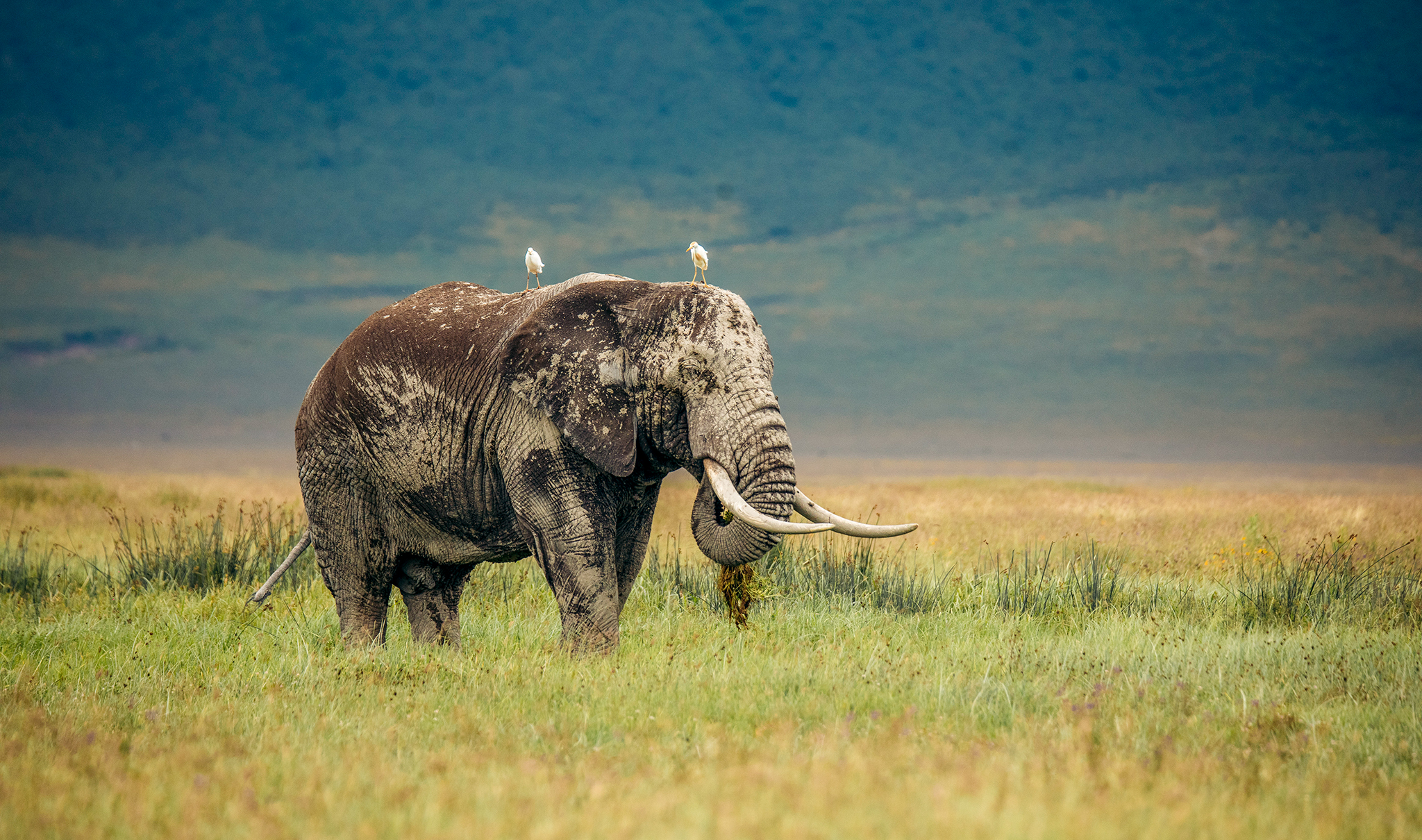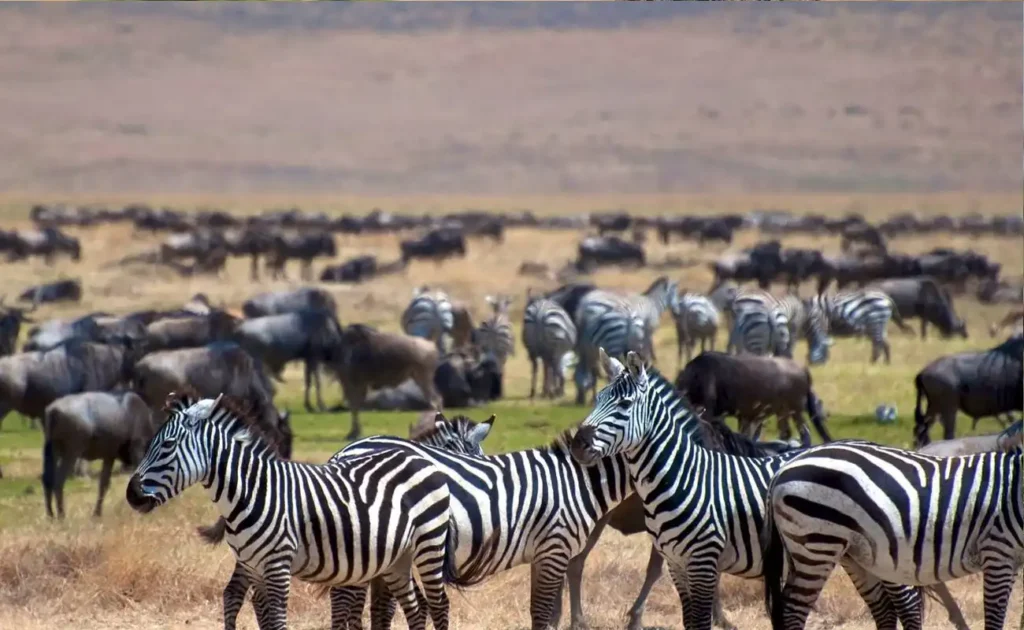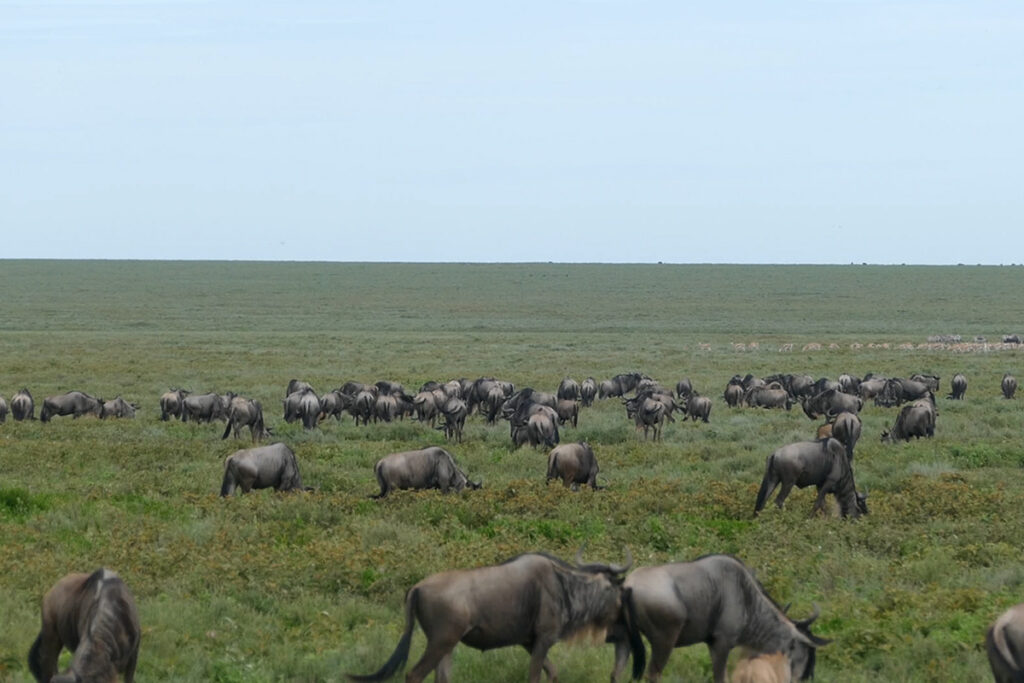Home to one of the most diverse ecosystems on the planet, the Ngorongoro Crater boasts unparalleled wildlife viewing. Among its residents, the crater harbors the densest population of large mammals in Africa. Here, you’re likely to witness a breathtaking congregation of species, from the majestic African elephant to elusive predators like the leopard.
The Ngorongoro Crater, a UNESCO World Heritage Site, shelters over 25,000 animals. Among the most notable are the threatened black rhinoceros, often seen grazing in the open grasslands. Additionally, the crater’s alkaline soda lakes attract flocks of flamingos, creating a stunning pink vista against the backdrop of the African landscape.

Exploring the Wildlife of Ngorongoro Crater
Ngorongoro Crater is a wildlife paradise. Here, you can find some of the most impressive animals in Africa, including the famous Big Five. The Big Five include lions, elephants, leopards, rhinoceroses, and buffalos. These animals roam freely in the vast and diverse landscape of the crater. Spotting them is an unforgettable experience.
In addition to the Big Five, the Ngorongoro Crater is home to a diverse range of bird species. With over 500 species recorded, bird enthusiasts will be thrilled. From vibrant flamingos to the majestic crowned crane, the crater offers a birdwatcher’s dream come true. The lakes and marshes here provide the perfect habitat for these feathered creatures.
Each habitat within the crater supports different types of wildlife. The open grasslands are perfect for grazing animals like zebras and wildebeests. The forested areas provide shelter for elephants and monkeys. The varied ecosystem ensures that every visit to the crater reveals something new and exciting. The crater’s diverse habitats are what make it a unique place.
Conservation efforts are crucial for protecting the wildlife of Ngorongoro Crater. Numerous organizations work tirelessly to preserve endangered species like the black rhino. Anti-poaching measures and habitat restoration projects are essential parts of these efforts. Visitors can also play a role by supporting eco-friendly tourism practices. Together, we can ensure the beauty of Ngorongoro Crater remains for future generations to enjoy.
The Big Five: Icons of African Wildlife
The Big Five are the stars of the Ngorongoro Crater. This term originally referred to the most challenging animals to hunt on foot. Today, it represents the crown jewels of African wildlife. The Big Five include the lion, elephant, leopard, rhinoceros, and buffalo. Seeing these animals up close is both thrilling and awe-inspiring.
The lion, often called the “king of the jungle,” is a commanding presence in the crater. Male lions, with their impressive manes, are particularly striking. Prides of lions can often be seen lounging in the sun or stalking prey. These predators play a key role in maintaining the balance of the ecosystem. Their roars can be heard from miles away.
Elephants, the largest land mammals, are gentle giants. They roam the crater with grace, often seen in family groups. Their interactions and social bonds are fascinating to observe. Despite their size, elephants are surprisingly quiet as they move. Their trunks are incredibly versatile, used for feeding, drinking, and communication.
Each of the Big Five animals brings something unique to the Ngorongoro Crater experience. The elusive leopard blends seamlessly into the environment. Rhinos are symbols of conservation efforts due to their endangered status. Buffalos, with their herds, showcase remarkable teamwork for defense. Witnessing these iconic animals is a highlight of any safari visit.
Diverse Bird Species in Ngorongoro
Ngorongoro Crater is a haven for birdwatchers. The crater hosts over 500 bird species, making it a birding paradise. From small finches to mighty eagles, there’s something for every bird enthusiast. The varied habitats support a rich diversity of avian life. Observing these birds in their natural habitats is a visual treat.
The crater’s lakes are particularly popular among waterbirds. Flocks of flamingos create a stunning pink landscape against the blue waters. Pelicans, herons, and storks can also be seen fishing in these waters. These birds rely on the lake’s rich food supply for survival. Their presence adds to the crater’s vibrant ecosystem.
Forest areas provide shelter for species like turacos and hornbills. The colorful plumage of many forest birds is mesmerizing. They flit through the trees, filling the air with their melodies. Some of these birds are elusive, requiring patience and keen observation. Spotting them is a rewarding experience for any birdwatcher.
To enhance your birdwatching experience, consider the following list of essentials:
- Binoculars for a closer view
- A bird guidebook for identification
- A camera to capture beautiful moments
- Comfortable clothing and shoes for long walks
- Patience and a keen eye
Using these tools will help make your birdwatching adventure in Ngorongoro Crater extraordinary.
Unique Habitats and Their Inhabitants
Ngorongoro Crater is a microcosm of various habitats, each with its unique inhabitants. The crater floor is a mosaic of grasslands, swamps, forests, and lakes. These diverse environments provide shelter to a wide range of animals. Each habitat supports different species, contributing to the region’s biodiversity. Exploring these habitats reveals fascinating interactions between animals and their surroundings.
The open grasslands are perhaps the most striking feature of the crater floor. These expanses are home to large herds of grazers like zebras, wildebeests, and antelopes. They coexist with predators such as lions and cheetahs. The grasslands also support smaller animals like warthogs and various rodents. This habitat provides ample opportunities for observing dynamic predator-prey relationships.
Swamps and wetlands serve as crucial habitats for many animals. Hippos are often seen wallowing in these areas, staying cool during the day. Waterbucks and reedbucks thrive in the lush vegetation near the water. Crocodiles too, can be spotted lurking under the surface, waiting for their next meal. These wetland areas are also hotspots for birdlife, attracting species such as storks and ibises.
Riverine forests offer a stark contrast to the open grasslands. These wooded areas are a refuge for many species that prefer dense cover. Elephants often seek shelter here, forming paths through the thick foliage. Baboons and monkeys are common, adding lively activity to the forest. The trees also provide nesting sites for various birds and food sources for insects and other small creatures.
Finally, Ngorongoro’s lakes are beautiful yet essential features of the crater. These alkaline lakes attract large flocks of flamingos, turning the shores pink. The lakes are also vital for other waterfowl and aquatic life. Peering into the water, you might spot fish and amphibians that call the lakes home. These bodies of water serve as vibrant hubs of biodiversity within the crater.
Endangered Species and Conservation Efforts
Ngorongoro Crater is a sanctuary for several endangered species. Among them, the black rhinoceros stands out due to its critical status. These majestic animals are often targeted by poachers for their horns. For this reason, conservation efforts in the crater focus heavily on protecting these rhinos. Seeing one in the wild is a rare and unforgettable experience.
Conserving endangered species requires a multifaceted approach. Various organizations work together to implement anti-poaching measures. These include increased patrols, advanced monitoring systems, and severe penalties for poaching. Local communities also play a vital role in these efforts. By educating and involving them, they become guardians of their natural heritage.
Conservation isn’t limited to just animals; it extends to the habitats they live in. Restoring and preserving these environments helps maintain the delicate balance of nature. Reforestation, wetland preservation, and erosion control are examples of such efforts. Healthy habitats ensure that endangered species have a safe place to thrive. Sustainable tourism also supports these initiatives.
To track the progress of conservation efforts, scientists rely on data and research. They use drones, camera traps, and GPS collars to monitor wildlife. These technologies provide valuable insights into animal movements and behavior. Such data helps in making informed decisions for conservation strategies. Continuous research ensures that efforts are effective and adaptive to changing conditions.
Ngorongoro’s success in conservation is a collaborative achievement. Supported by tourists, governments, and conservationists, these efforts show positive results. Visitors can contribute by choosing responsible tourism options and spreading awareness. A united front in conservation ensures a brighter future for endangered species in the crater. Together, we can make a difference.




